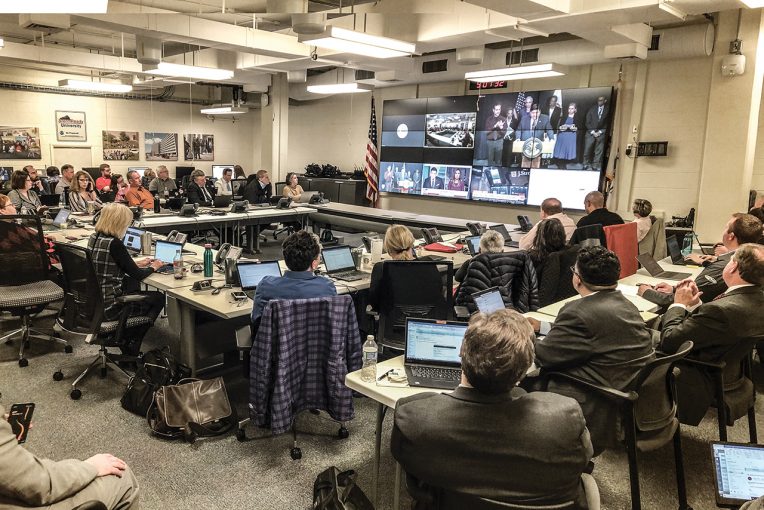Collaboration is one of Illinois State’s core values. Never before has it been more apparent or vital than with the planning required to continue the University’s learning and teaching in the midst of the coronavirus (COVID-19) pandemic.
From the transition to distance learning when the virus rapidly spread across the country during the spring semester to plans for the fall term that evolved during the summer, Illinois State’s response has been cautiously contemplated
and implemented.
President Larry Dietz relied on partnerships across the University as he orchestrated the work required to determine when and how students would return to campus. There were 15 teams of diverse individuals representing all areas of the institution assembled to create the blueprint titled Redbirds Return.
Beyond reflecting federal, state, and local COVID-19 guidelines, Illinois State’s 17-page document made clear the priorities established by Dietz. The first was to keep students, faculty, and staff healthy and safe. The second was to provide during the fall semester educational opportunities and inclusive experiences on campus in a manner as near to normal as possible.
The task was monumental, given all planning was done in the midst of uncertainty.
“The past months have been anything but easy,” said Dietz, who has led the University through unprecedented times by using both his head and his heart. He acknowledged in video forums scheduled with parents and students that beyond his administrative role, he is a father and grandparent who understands the concerns about safety and a desire to know what is ahead.
“I share the thirst for plain and simple answers. But by all accounts, simple answers have been far too few of late,” Dietz said. “The Greek philosopher Heraclitus said ‘The only thing that is constant is change.’ Never has that statement rung truer than throughout the COVID-19 pandemic and how our nation, state, and the University have responded to its numerous challenges.”
Crisis preparation done far in advance helped Illinois State be in a position to react quickly. The University had developed in 2009 as a result of the H1N1 outbreak a document detailing how to handle a pandemic. It served as a starting point in responding to COVID-19. Even more significant was the culture of preparedness created over the past several years, which has made the campus community ready for incidents caused by human action, created through nature, or connected to technology.
Eric Hodges has championed the effort as director of ISU’s Emergency Management since 2013. He initiated creation of an incident management team and Emergency Operations Center (EOC). Fully equipped with technology and space for staff from every vice presidential area, the EOC has been headquarters for managing the virus at ISU.
Hodges was monitoring the spread of COVID-19 beyond China early in the year and sent out his first briefing in January. By the first week of February, the entire EOC team convened.
Staff chosen for an EOC role are subject-matter experts in their field and full-time ISU employees who have undergone extensive training. They separated into more than a dozen groups that worked long days and weekends as they explored options, discussed ways to execute decisions, and managed communicating with ISU’s audiences.
Internal conversation focused on travel advisories and study abroad programs initially, but rapidly transitioned into discussion about daily campus operations. By early March Dietz, the vice presidents, and other cabinet members joined EOC conversations that were scheduled for at least a couple of hours daily through the spring.
The situation required major decisions be made rapidly, from having students vacate residence halls and moving spring classes to an online format to replacing the traditional commencement in May with a virtual celebration. All were gut-wrenching because every aspect of the Redbird experience was disrupted.
“I was so impressed with the willingness of the faculty and staff to pitch in and learn a different way of teaching to serve our students, and the student’s willingness to pursue a different way of learning,” Dietz said in reflecting on how the spring semester ended. Throughout the summer session, which was also conducted via distance learning, he heard a consistent hope for a return to campus by August. The University community was equally eager for students to again be able to experience the Redbird collegiate life.
“We conducted our planning for the fall semester classes with three scenarios in mind: completely in-person, completely online, or a blended approach,” Dietz said. The Redbirds Return plan details how students this fall will experience a blended approach to instruction, with classes taught face-to-face and in hybrid and online formats. They will live on campus and in adjacent off-campus apartments—study in Milner Library, work out in the Student Fitness Center, get a coffee at the Bone Student Center, and enjoy the fall beauty of the University Quad.”
There will be noticeable changes, from physical distancing and masks required to limiting the number of individuals at events. Details of the plan are shared online at Coronavirus.IllinoisState.edu/Fall-2020.
“We have evaluated every aspect of the residential college experience and are working to mitigate health risks,” Dietz said, expressing his appreciation for all who partnered to keep ISU operational and prepare for students to return this fall. The work has resulted in the University remaining strong and stable despite the havoc created around the world and across the country by COVID-19.
“The global crisis is forcing change upon many industries, and education is surely not to be spared,” he said. “Still Illinois State remains on our path to becoming even more renowned as a comprehensive institution with a focus on access and affordability, located in a top college town, delivering outcomes that rival flagship universities.”

